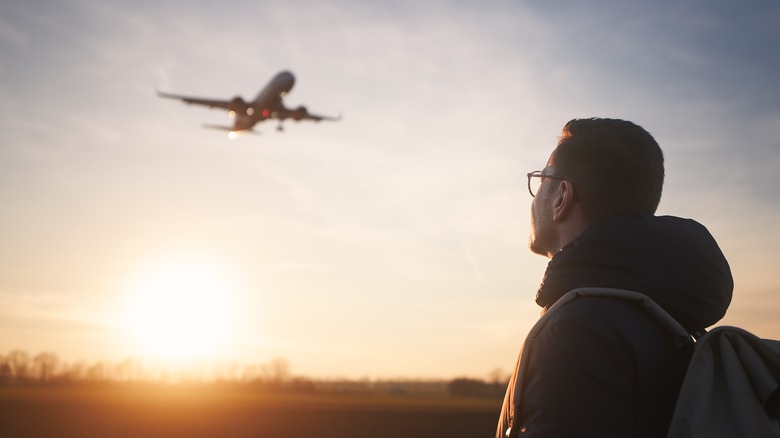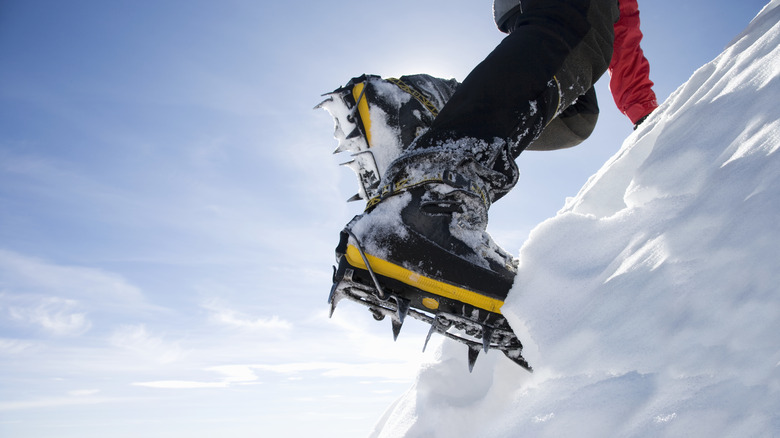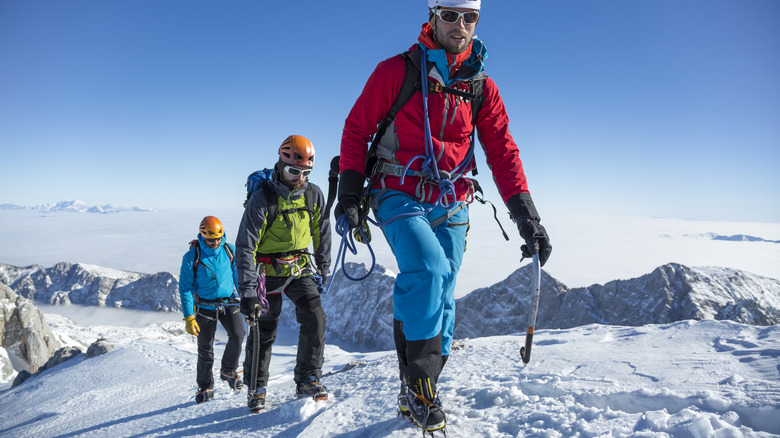TSA's Guidelines Allow You To Pack This Common But Intimidating Piece Of Climbing Gear
To climb a mountain, you have to have the right equipment, and a lot of mountaineers are also avid gearheads. They spend their spare cash on helmets, nylon ropes, insulated boots, and altimeter watches. If you want to give a birthday gift, mountain climbers will gratefully accept a new headlamp or pulley. Special tents are great, as are properly rated sleeping bags. Above all, they cherish the most symbolic of their tools, the mythic ice axe.
Mountaineers also tend to be travelers. Unless you live in, say, Colorado, within a reasonable drive of the famous "14ers" (the state's 58 peaks over 14,000 feet), then you'll likely have to fly to ever-more-impressive ranges. This is part of the fun, of course; once an Oregonian has bagged Mt. Hood (elevation 11,245 feet), the next step might be Washington's Mt. Rainier (14,410 feet). After that, maybe Kilimanjaro, or the Andes, or the Himalayas. Any trip will cost something, but there are at least 10 incredible mountain climbs that don't cost a fortune. There's nowhere to go but up, and it's usually a plane that will get you there.
Luckily, you can take all this equipment with you, even the weapon-like ice axe, as long as you store it in checked bags. This is just as well; you won't need a hex or nut extraction tool while you fly, and it's best to keep all your stuff together, where it's protected and organized. But incredibly, there's one piece of equipment you may be able to take with you in your carry-on bag: the spiked, steel foot-braces known as "crampons."
Crampons, the most unlikely thing you can fly with
But wait, does TSA really allow crampons on a plane? Considering all the unexpected things you can't bring through TSA, like British Christmas crackers and the Galaxy Note 7, why on earth would a set of jagged steel ovals make the, er, cut? These things look like something a ninja would use to scale a wall and then maybe fight off palace guards. Unlike other sharp objects, like a bicycle's gear cassette or a pair of knitting needles, these are literally designed to hack into solid surfaces. These would seem very easy to convert into some kind of weapon.
If you're wondering what the rationale is, the official regulations are a little vague on this point. "Crampons are generally permitted in carry-on bags," states the TSA website. "However, TSA officers have the discretion to prohibit an item if they feel it may pose a security threat." In other words, crampons may be permitted, but they might also be prohibited, depending on the officer's judgment in the moment.
This puts mountaineers in an awkward position. Should you risk packing crampons in your carry-on bag, knowing that they might be rejected at the last minute? These accoutrements aren't exactly cheap, regularly costing alpinists $150 to $250 per quality pair, and they're both specialized and odd-looking, meaning that TSA agents may not recognize what they are or know their intended purpose. You don't want to have to explain a rubber ring studded with miniature knives while ornery travelers crowd behind you at the X-ray machine.
How to travel with crampons
In short, you should probably stow your crampons in your checked bags, along with the rest of your equipment. You won't need to wear them onboard, and while lost baggage is always a possibility, you'll likely lose the rest of your equipment as well, postponing your ascent anyway. If this misfortune does befall you, here are the best things to do when an airline loses your checked baggage, according to a travel agent.
There are other options as well. Many climbers join tour groups, which often supply their own equipment. While some outdoorspeople are pickier about sizing or brand names, others will accept any helmet or rope that's comfortable and safe. Crampons are extremely adjustable; a set of Grivel Air Tech Hybrid Dual-Matic EVO crampons, for example, are designed to fit men's U.S. sizes 4 through 12, which covers just about any male foot, and the same pair is designed for women with shoe sizes 4 through 13. If you're joining an organized climb and want to fly light, check with the tour company about provided gear. Independent mountaineers may also find nearby outfitters that rent out essentials; where there's a climbable mountain, there's almost always a well-stocked store.
There's one more option, if you know where you're staying: You can ship equipment to a specific address. This is a common practice among cyclists and skiers, who don't want to lug unwieldy equipment through an airport or risk damage en route. You may also save money in the long run, depending on how much specialty gear you need to bring; "sports equipment" often makes up a separate category among airline baggage policies, and prices can get hefty. You can mail your crampons just about anywhere in the world without a hitch. That way, you can start your adventure steady on your feet.


